The AMD Ryzen Threadripper 3960X and 3970X Review: 24 and 32 Cores on 7nm
by Dr. Ian Cutress, Andrei Frumusanu & Gavin Bonshor on November 25, 2019 9:05 AM ESTPower Consumption
One of our key conclusions from our Ryzen 9 3950X review is that AMD’s TDP number on the box was now somewhat a blurred line, with the processor instead taking the ‘Package Power Tracking’ or PPT value as its true peak power consumption. This meant that for a processor to have 105 W TDP on the box, the default PPT of 142 W meant that we saw power consumption around 142 W rather than 105 W. One concern going into this review is that AMD would take a similar line with the Zen 2-based Threadripper parts as well.
Both of the TR 3960X and TR 3970X processors have a list box TDP of 280 W, which is a new ‘record’ for high power consumption in a consumer CPU. In the enterprise space we see some specialist processors break the 400W mark, but those CPUs exist in environments with a variety of cooling methods and sound isn’t much of a concern. Conversely, these AMD processors will have to live in a box under someone’s desk, so there has to be a point where the TDP is too much. Last AMD generation was 250W, this one is 280W: if we’re not there already, then this should be a practical limit. AMD of course recommends liquid cooling with a good pump and a big radiator, so anyone buying one of these processors should look into spending at least another $120+ on a good liquid cooling system.
For our power consumption metrics, we performed our usual testing: using an affinity mask to limit the cores in use, implement a high-powered workload, and then measure the power readings 30 seconds in. We take the power readings from the processor itself, using the internal registers that are designed to regulate how much the processor does a form of turbo but also regulate temperatures and so forth. This method is broadly accurate, assuming the motherboard supports the external reporting of these values, but depending on the processor family it also gives us insights into how much power is being derived from the cores individually and the package as a whole.
Here’s what we get for the 24-core 3960X:
When a single core is active, it consumes ~13.5 watts. This slowly goes down when more cores get loaded, but at 6 cores loaded we are still consuming ~12 watts per core. Even at 16 cores loaded, we’re still around 10 watts per core. This is pretty impressive. At full core loading, we’re fluctuating between 6 and 11 watts per core, as workloads get moved around to manage core loading.
From the peak power perspective, we hit 280 W with 22 cores loaded. It drops off a bit after that, like we saw with the Ryzen 9 3950X, but not by much at this time. It should be noted that as we reach these higher values, out of those 280 W, around 205 W is being used by the cores, while 75 W or so is for everything else: that means memory controllers, PCIe root complexes, and the infinity fabric. This 75 W value doesn’t vary that much, starting at 68 W even at single core load. This indicates that either IF doesn’t take much power as more cores are used, or it is on all the time.
Moving to the 3970X, and we see a similar picture:
With more cores, the power is spread around a lot more. One core loaded tops out at 13 watts, and at 11 cores loaded we can still manage above 10 watts per core. When fully loaded, we move down to as low as 3 W per core, but it does average out to around 6 watts per core. Checking the frequency at this loading and despite the 3.7 GHz base frequency, we actually have all the cores at 4.0 GHz. 32 cores at 4.0 GHz? Yes please.
The peak power metrics rise to just over 280 W when we hit 23 cores loaded and stay there, with no dip after hitting the peak. It would seem that the 3970X appears better built in that regard.
If we comment on the power between the cores and everything else, we again get a 205-210 W value for the power in the cores. This leaves 75 W or so for the rest of the chip, almost identical to the 3960X, and again this doesn’t waver much from 1 core loaded to all-cores loaded.
What will be interesting to see will be when we get the 3990X in to test as comparison. I expect that 75W value to go up – even if it goes to 100W, that leaves 180W for 64 cores, or around 3 W per core. Based on my estimates, we could be looking at anywhere from 3.0-3.5 GHz per core, which actually fits in nicely with the frequencies of the EPYC 7H12 which is also a 64-core 280W part, but for the high performance compute market.
When comparing peak power consumption to all the other CPUs in our review, as expected our new CPUs are near the top of the charts.
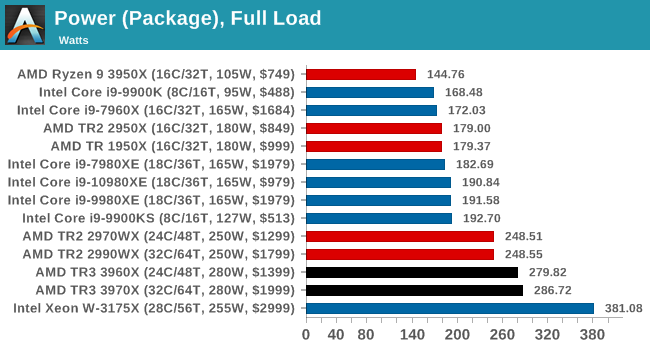
Only the unlocked 28-core from Intel peaks at a higher power, but funnily enough, that should only have a 255W TDP. So for four more cores, AMD’s peak power is still 100W below Intel’s. That’s the ‘power’ of the 7nm process node and some good quality chiplets.


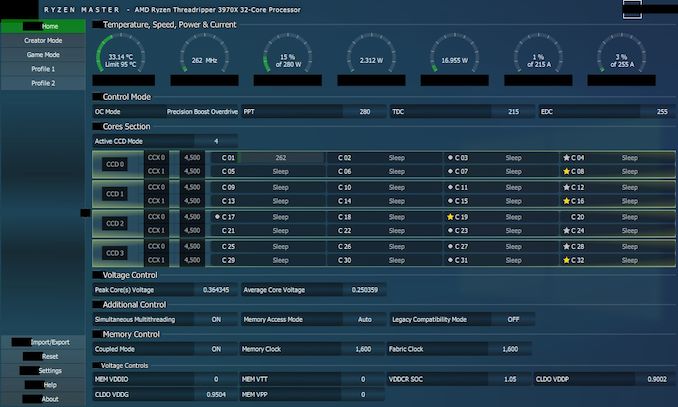
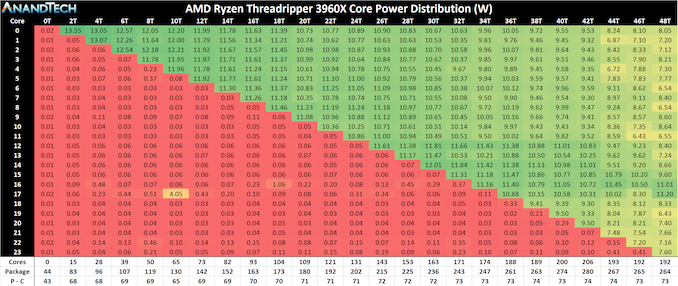
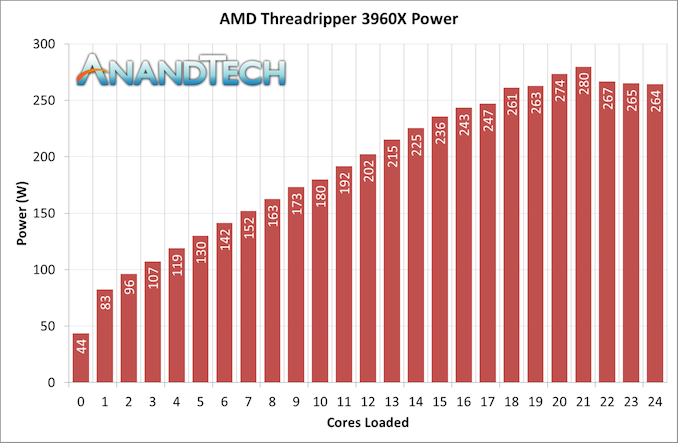
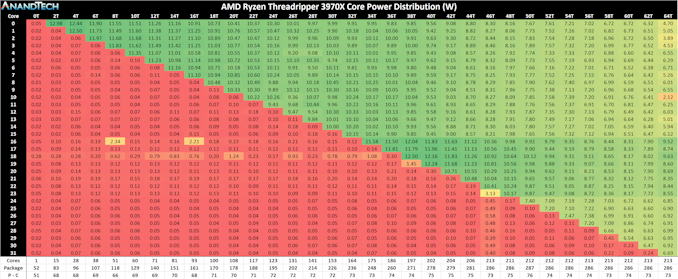
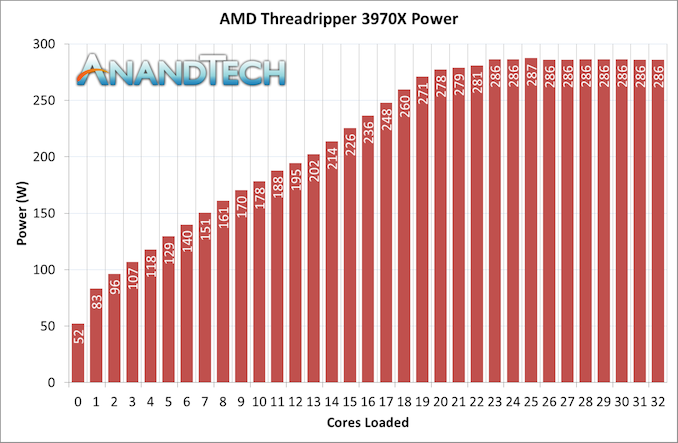








245 Comments
View All Comments
yeeeeman - Monday, November 25, 2019 - link
What is so surprising? It has better ipc and the multi threading efficiency is better than hyper threading in Intel. Hence the result.realbabilu - Monday, November 25, 2019 - link
Wish Goto Openblas optimize Blas on Windows this AMD processor for floating point calculation (especially AVX) otherwise Intel MKL that optimized for Intel processor only is used by most FEA industry like Ansys, Abaqus, Nastran. To get all juice out,it need optimized on how much size cache it got.M O B - Monday, November 25, 2019 - link
Can anyone find these actually for sale anywhere? These reviews look great, but I'm not here for a paper launch.wishgranter - Monday, November 25, 2019 - link
My Quad Xeon 4880 @2,5 Ghz ( 60 cores - 120 Threads ) + 1,5 TB RAM is on same performance as the TR3 3970x !!! at least on Corona Benchmark for now..rahvin - Monday, November 25, 2019 - link
And for consolation you're using about 10X as much power. I bet it costs $20 a day to have that monster on.|Tubbs| - Monday, November 25, 2019 - link
Would have liked to see some visual studio code compile benchmarks. Our developers could use some faster machines imo.TEAMSWITCHER - Monday, November 25, 2019 - link
I'm pretty sure AMD doesn't allow them... They want to skew the benchmark in their favor as much as possible. If you want to play with free hardware .. you have to agree to these things. It would be great if there was a site that didn't play these games... But.. The allure of "free stuff" drives the motivations of everyone in Tech News business.upanddown - Monday, November 25, 2019 - link
I'm pretty sure you've already seen these VC benchmarks? Looking forward for the link to it.Xyler94 - Monday, November 25, 2019 - link
Sites like anandtech usually don't benchmark things like VB code and such. It really has nothing to do with AMD or Intel telling them what to benchmark, it has everything to do with giving a general idea of a processor's performance.When looking at reviews, you should go to the ones who you know benchmark those titles you want. There's not a lot of demand to do VB Code stuff, so no one does it really.
As an aside, Intel suggested reviews don't use Cinebench R15/20 because "It isn't realistic", but it runs on Maxon Cinema 4D, a real and widely used in the professional scene rendering application that studios like Disney and Pixar could use (I don't know if they do). But because no consumer would use such a thing, Intel said don't use it. So would AMD be in the wrong for suggesting not using VB Code? Yes, because Intel shouldn't dictate what reviews use either.
rahvin - Monday, November 25, 2019 - link
Oh please. Butt hurt much?There was a developer studio just a week ago that published benchmarks for switching out just one of their compilation boxes to a Ryzen 3700 and it smoked the other boxes they had by about 40%.